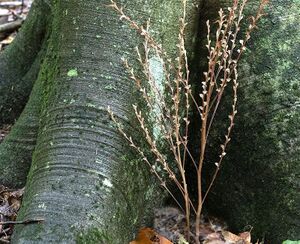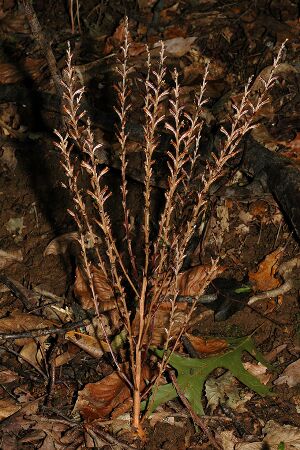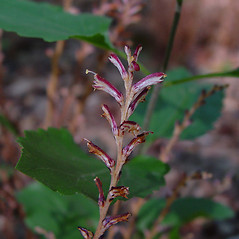Beechdrops
Beechdrops (Epifagus virginiana) is an obligate parasitic plant, lacking chlorophyll, that obtains nutrients and water solely from the roots of American beech trees. The name Epifagus originates from the Greek prefix "epi", translating to "upon", while "Fagus" is the genus name of beech.

Taxonomy
- The genus Epifagus is monotypic, only containing E. virginiana within it.
| Kingdom | Phylum | Class | Order | Family | Genus | Species | |
|---|---|---|---|---|---|---|---|
| Classification | Plantae | Angiosperms | Magnoliopsida | Lamiales | Orobanchaceae | Epifagus, Nutt. | E. virginiana |
Description and Characteristics

Beechdrops averagely reach heights of 6-20 inches (15-50 cm.) at maturity. The plants are generally brown in coloration, commonly being mistaken as woody plants. Beechdrops are herbaceous, however. The stems and branches are skinny; ranging in color from yellow to darker reddish shades of brown, with vertical purple stripes that may darken with age. The leaves are underdeveloped and difficult to distinguish, appearing similar to small scales [2].
The visible flowers are small and tubular, growing alternately along the stems. After blooming in early autumn, between August and October, the flowers are a mixture of deep burgundy and cream [3]. These upper flowers are labeled as chasmogamous, or showy flowers. They grow about one inch long, on average, and are usually sterile. Bumblebees and ants are believed to be the primary pollinators of these chasmogamous flowers. The flowers on the lower base of the stem, in contrast, are self-fertilizing and do not open [1]. They are much smaller and more inconspicuous than the showy flowers, also being referred to as secret or cleistogamous flowers.

Host Trees
Beechdrop plants can be found emerging at the base of American beech tree trunks. Beechdrops develop haustorium structures, allowing them to penetrate and grow into beech roots. This is necessary for the purpose of extracting nutrients, as the plants are not able to photosynthesize or produce food without the presence of chlorophyll [1]. Therefore, these parasitic plants depend entirely on beech trees for survival.
As the plants mature, the haustorium begins to diminish as an enlarged root tuber develops. Eventually, the parasitic plant and the host tree are connected through their roots and the beechdrops' tubers, instead of through the haustorium [3]. Since beechdrops are an annual flower that completely die off every fall, they have not been observed to cause lasting damage or harm to the host trees.
Life Cycle
A fairly inconspicuous brown stem produces two types of flowers, cleistogamous flowers that self-pollinate without ever opening, and chasmogamous flowers that open, but are often sterile [1]. The roots of the host release a chemical that trigger the germination of E. virginiana. It is believed that the older the host tree, the more this chemical is released. Seeds from E. virginiana are small and are dispersed by rainwater. Between dispersal and germination, seeds experience a cellular change, the embryo changes colors and its cells develop granules. This insect pollination is required for pollination in the chasmogamous flowers. E. virginiana relies upon ant pollination to produce cross pollinated seeds along with self-fertilized seed. It is not believed that ants pollinate the self-fertile cleistogamous flowers Epifagus virginiana germinates when a chemical signal is released from the beech tree’s roots. During early stages of development, beechdrops lives independently from its host, instead relying on nutrients from the seed. It may take several years for an above ground structure to form. These early stages E. virginiana are a few millimeters in size and butter yellow.[9] Beechdrops then develops a haustorium that grows into the host’s roots. At maturity the haustorium degrades and a tuber develops. During late summer and early fall E. virginiana flowers. B
Habitats and Environment
This parasitic plant is native to North America and can most often be found along the edges of temperate forests and woodlands, as well as rocky wooded slopes where the American Beech and Sugar Maple trees are commonly codominant [2]. Beechdrops primarily inhabit wooded habitats across Eastern Canada and throughout the Midwestern region of the United States. They have been documented significantly in the states of Indiana, Ohio, and Michigan. Though, these plants have also been observed along the East Coast from Maine to South Carolina, and even as far down as Texas. Beechdrops are used to monitor forest health because of their dependence on their host and the sensitivity to its environment. E. virginiana’s host, beech trees, can advance in a forest faster than E. virginiana is able to. The presence of F. grandifolia is used to predict when E. virginiana will arrive in an area.[12] E. virginiana is not a tree health concern but the lack of its presence is a sign that forest health is declining.
Sources
[1] Native Plant Trust: Go Botany. Epifagus virginiana — beech-drops. (nd.). https://gobotany.nativeplanttrust.org/species/epifagus/virginiana/
[2] Beechdrops, Epifagus virginiana, Broomrape family (Orobanchaceae). (nd.). https://illinoiswildflowers.info/woodland/plants/beechdrops.htm
[3] Smith, Hanna. Beechdrops – A Native Parasitic Plant. 2020, October 15. https://guilford.ces.ncsu.edu/2020/10/beechdrops-a-native-parasitic-plant/?msclkid=99aa5e85c80a11ec954348e12a6e822c
[4] Virginia Native Plant Society. A Parasitic Lifestyle: Beechdrops and Their Relatives. 2020, December 16. https://vnps.org/a-parasitic-lifestyle-beechdrops-and-their-relatives/?msclkid=5bd24179c80f11ec9c562ee1da7a1db1